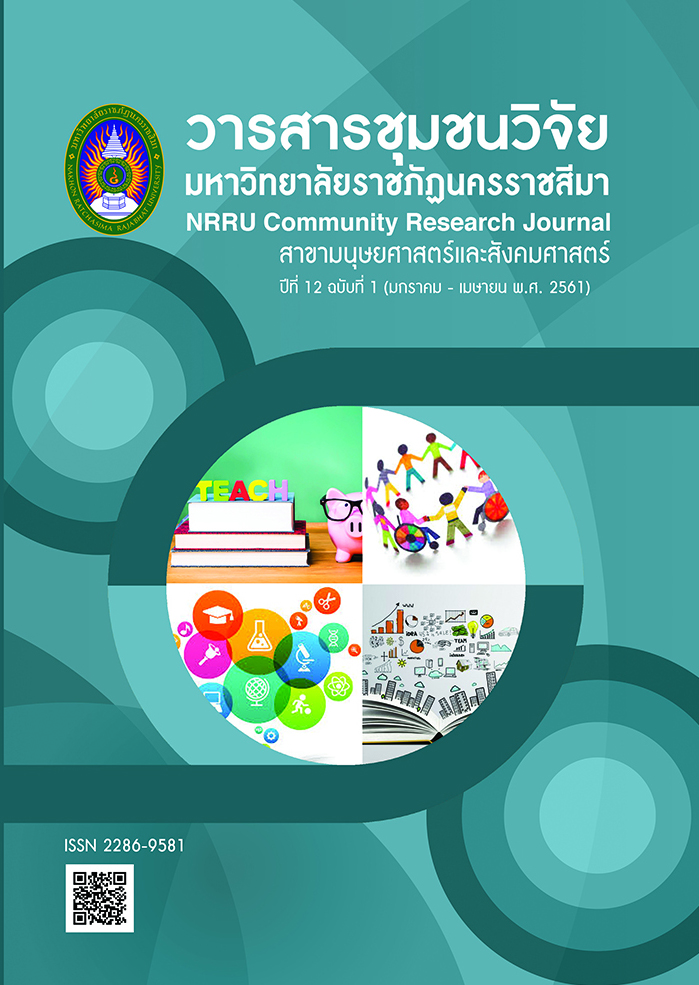อิทธิพลของปัจจัยที่มีต่อความภักดีของนักท่องเที่ยว ต่อการท่องเที่ยวบนฐานชุมชน ภาคตะวันออกเฉียงเหนือตอนล่างของประเทศไทย
คำสำคัญ:
การท่องเที่ยวบนฐานชุมชน, ภาพลักษณ์การท่องเที่ยว, คุณภาพการบริการ, ประสบการณ์ที่ได้รับ, คุณค่าที่ได้รับในการท่องเที่ยว, ความพึงพอใจของนักท่องเที่ยว, ความภักดีของนักท่องเที่ยวบทคัดย่อ
การวิจัยครั้งนี้มีเป้าหมายเพื่อศึกษาอิทธิพลของปัจจัยที่มีต่อความภักดีของนักท่องเที่ยวต่อการท่องเที่ยว บนฐานชุมชนภาคตะวันออกเฉียงเหนือตอนล่างของประเทศไทย โดยมีวัตถุประสงค์เพื่อ 1) ศึกษาภาพลักษณ์การท่องเที่ยวบนฐานชุมชนภาคตะวันออกเฉียงเหนือตอนล่าง คุณภาพการบริการ ประสบการณ์การท่องเที่ยวมีอิทธิพลต่อคุณค่าที่ได้รับจากการท่องเที่ยวและความพึงพอใจของนักท่องเที่ยว และ 2) ศึกษาคุณค่าที่ได้รับจากการท่องเที่ยวและความพึงพอใจของนักท่องเที่ยว มีอิทธิพลต่อความภักดีการท่องเที่ยวบนฐานชุมชนภาคตะวันออกเฉียงเหนือตอนล่างของประเทศไทย โดยมีกลุ่มตัวอย่างเป็นนักท่องเที่ยวที่เดินทางมาท่องเที่ยวชุมชนภาคตะวันออกเฉียงเหนือตอนล่างของประเทศไทยที่ใช้การจัดการการท่องเที่ยวบนฐานชุมชน จำนวน 400 คน เครื่องมือที่ใช้ในการวิจัย คือ แบบสอบถาม สถิติที่ใช้ในการวิเคราะห์ ได้แก่ ค่าร้อยละ ค่าเฉลี่ยส่วนเบี่ยงเบนมาตรฐาน และทดสอบสมมติฐานด้วยการวิเคราะห์การถดถอยแบบพหุคูณผลการวิจัย พบว่า 1) ภาพลักษณ์การท่องเที่ยวบนฐานชุมชนภาคตะวันออกเฉียงเหนือตอนล่าง คุณภาพ การบริการ ประสบการณ์การท่องเที่ยวมีอิทธิพลต่อคุณค่าที่ได้รับจากการท่องเที่ยวและความพึงพอใจ ของนักท่องเที่ยว อย่างมีนัยสำคัญทางสถิติที่ระดับ 0.05 และ 0.01 2) คุณค่าที่ได้รับจากการท่องเที่ยวและความพึงพอใจของนักท่องเที่ยว มีอิทธิพลต่อความภักดีการท่องเที่ยวบนฐานชุมชนภาคตะวันออกเฉียงเหนือตอนล่างของประเทศไทย อย่างมีนัยสำคัญทางสถิติที่ระดับ 0.05 และ 0.01 และ 3) มีตัวแปรเพียง 2 ตัวที่ไม่มีอิทธิพลต่อความพึงพอใจของนักท่องเที่ยว ได้แก่ คุณภาพการบริการด้านรูปธรรมการบริการและด้านความมั่นใจ
References
มหาวิทยาลัย.
ดอน นาครทรรพ. (2558). มองภาพใหญ่ ท่องเที่ยวไทย 2558. สัมมนาทิศทางอุตสาหกรรมการท่องเที่ยว
ต่อภาพรวมเศรษฐกิจของไทย โอกาสและอนาคตของธุรกิจท่องเที่ยวและบริการ (หน้า 2).
กรุงเทพมหานคร : ธนาคารแห่งประเทศไทย.
Alegre, J., & Magdalena, C. (2006), “Destination loyalty: consumers’ economic behavior”.
Annals of Tourism Research, 33(3), 684-706.
Chen, C. F., & Tsai, D. (2007). How destination image and evaluative factors affect behavioral
intension?. Tourism Management, 28, 1115-1122.
Chung, C. C., Lee, H. C., & Lin, C. Y. (2016). The Study of Leisure Experience, Perceived Value
and Behavioral Intentions. Universal Journal of Management, 4(5), 314-321.
Cooper, C., Fletcher, J., Gilbert, D., & Wanhill, S. (1993). In Tourism: Principles and Practice.
Harlow : Longman Scientific and Technical.
Cooper, D. R., Schindler, P. S., & Sun, J. (2006). Business research methods. (9th ed.).
New York : McGraw-hill.
Craggs, R., & Schofield, P. (2011). The Quays in Salford: an analysis of visitor perceptions,
satisfaction and behavioral intention. International Journal of Tourism Research, 13,
583-599. https://doi.org/10.1002/jtr.831
Echtner C. M., & Ritchie, J. R. B. (2003). The meaning and measurement of destination Image.
Journal of Tourism Studies, 2(2), 2-12.
Faullant, R., Matzler, K., & Fuller, J. (2008). The impact of satisfaction and Image on loyalty :
the case of Alpine ski resorts. Managing Service Quality, 18(2), 163-178.
Gounaris, S. P., Stathakopoulos, V., & Athanassopoulos, A. D. (2003). Antecedents to perceived
service quality: an exploratory study in the banking industry. The International Journal
of Bank Marketing, 21(4/5), 168-190.
Hossain, M. J. (2012). Impact of service quality on customer satisfaction: A case of tourism
industry in Bangladesh. International Journal of Research in Finance & Marketing, 2(2),
1-25.
Jay, K., & Hsin, H. H. (2007). Do hoteliers need to manage image to retain loyal customers?.
International Journal of contemporary Hospitality Management, 19(6), 435-443.
Karunaratne, W. M. K. K., & Jayawardena, L. N. A. C. (2010). Assessment of Customer Satisfaction
in a Five Star Hotel-A Case Study. Tropical Agricultural Research, 21(3), 258-265.
Lee, C. K., Yoon, Y. S., & Lee, S. K. (2007). Investigating the relationships among perceived
value, satisfaction, and recommendations: The case of the Korean DMZ. Tourism
Management, 28(1), 204-214.
Lee, F., Lee, C., & Lee, A. (2000). Statistics for Business and Financial Economics. (2nd ed.).
Singapore : World Scientific.
Lemon, K.N., Rust, R.T., & Zeithaml, V.A. (2001). What drives customer equity?. Marketing
Management, 10(1), 20-25.
Mangold, G., & Miller, F. (1999). Word-of-mouth communications in the service marketplace.
Journal of Service Marketing, 13(1), 73-90.
Markovic, S., & Raspor, S. (2010). Measuring Perceived Service Quality Using Servqual : A Case
Study of the Croatian. Hotel Industry Management, 5(3), 195-209.
McDougall, G. H. G., & Levesque, T. (2000). Customer satisfaction with service : Putting perceived
value into equation. Journal of Service Marketing, 14(5), 392-410.
Minh, N. H., Ha, N. T., Anh, P. C., & Matsui, Y. (2015). Service Quality and Customer Satisfaction:
A Case Study of Hotel Industry in Vietnam. Asian Social Science, 11(10).
Munusamy, J., Chelliah, S., & Mun, H. W. (2010). Service quality delivery and its impact on
customer satisfaction in the banking sector in Malaysia. International Journal of
Innovation, Management and Technology, 1(4), 398-404.
Osman, Z., & Sentosa, I. (2013). Mediating effect of customer satisfaction on service quality
and customer loyalty relationship in Malaysian rural tourism. International Journal of
Economics and Management Studies, 2(1), 25-37.
Ozturk, A. B., & Qu, H. (2008). The impact of destination image on tourists’ perceive value,
expectations, and loyalty. Journal of Quality Assurance in Hospitality and Tourism, 9(4),
275-279.
Parasuraman, A., Zeithaml, V. A. & Berry, L. L. (1985). “A conceptual model of service quality
and implications for future research”. Journal of Marketing, 49(4), 41-50.
Pine, B. J., & Gilmore, J. H. (1999). The Experience Economy. Harvard : University Press Harvard.
Rajan, V. (2015). Factors Affecting Tourist Destination Loyalty A Case Study of Munnar, India as
a Tourism Destination. International Conference on Business, Economics and
Management (ICBEM’15) April 9-10, 2015. Thailand : Phuket.
Rasheed, F. A., & Abadi, M. F. (2014). Impact of service quality, trust and perceived value on
customer loyalty in Malaysia service industries. Social and Behavioral Sciences, 298-304.
Tsiotsou, R. H., & Goldsmith, R. E. (2012). Strategic marketing in tourism service. Bingley,
UK : Emerald Group Pub.
Tung, F. C. (2010). Exploring customer satisfaction perceive quality and image: An empirical
study in mobile services. The Business Review, Cambridge, 14(2), 63-69.
Wirtz, J., & Chew, P. (2002). The effects of incentives, deal proneness, satisfaction and
tie strength on word-of-mouth behavior. International Journal of Service Industry
Management, 13(2), 141-162.
Yoon, Y., & Uysal, M. (2005). An examination of the effects of motivation and satisfaction
on destination loyalty: A structural model. Tourism Management, 26(1), 45-56.
Zeithaml, V. A., Bitner, M. J., & Gremler, D. D. (2009). Service marketing: integrating customer
focus across the firm. (5th ed.). Boston : McGraw-Hill Irwin.



